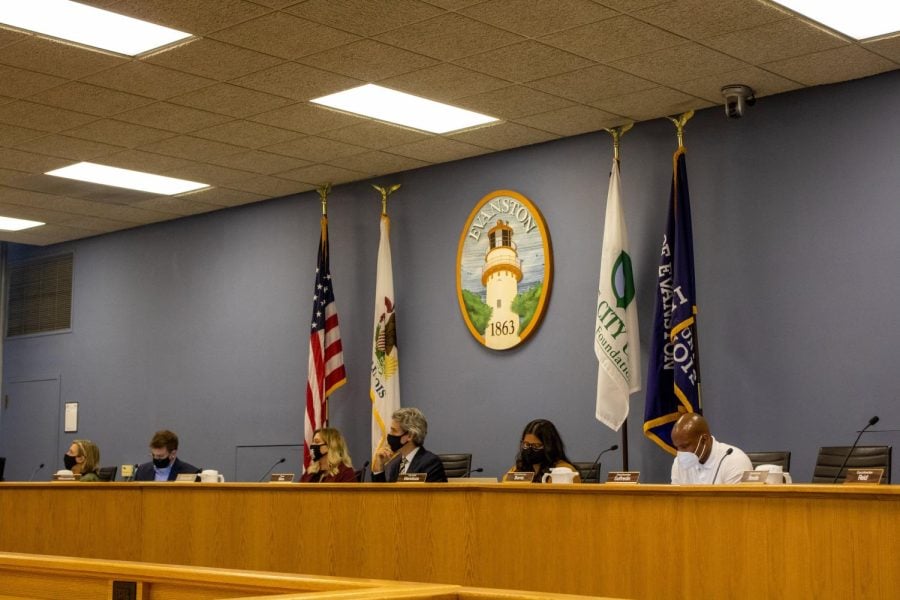New students, new leaders: Get to know Evanston politics
Daily file photo by Madison Smith
Incoming students can get to know their new home a little more by understanding Evanston’s politics.
August 12, 2022
With a population of just over 78,000, Evanston’s midsize political landscape is marked by a contrasting combination of big-city issues and small-town relationships.
The city’s history is shaped by redlining and a constant balance of dynamics with Chicago and Northwestern. In recent years, it’s caught national attention for a mix of breaking scandals and growing initiatives — plus, as Evanston considers redrawing the boundaries of its nine wards, its political composition may soon be shaken up beyond recognition.
Incoming students won’t just spend four years as a member of the NU community — they’re also temporary Evanston residents. One of the best ways to break out of the campus bubble is to be civically engaged and get to know the past and present politics of your new neighborhood, from campus to the Lorraine H. Morton Civic Center.
Council-manager system
Since 1952, Evanston has run on a council-manager form of government, in which the city is led by a city council, which includes the mayor, and a city manager.
This structure is the most common form of local government in the country, the National League of Cities reported, especially in cities with more than 10,000 residents.
The city manager oversees the budget and daily government operations, while alderpeople, or the members of City Council excluding the mayor, vote on policies and communicate directly with residents.
Students and other residents vote in their own wards for the council and mayor, and the city will roll out a referendum on ranked-choice voting this year.
Evanston’s current mayor, longtime resident and former state Sen. Daniel Biss, took office a little more than a year ago after a failed run for the Illinois governorship. In a recent address reflecting on his first year, Biss pledged to continue focus on economic rebuilding programs including guaranteed basic income.
Biss largely spent his first year on this, as well as addressing high turnover rates in city government, establishing mental health initiatives and executing Evanston’s pioneering reparations program. The latter will divert taxes on recreational cannabis sales to waves of funding for Black residents or descendants of Black residents who experienced housing discrimination within the city between 1919-1969.
All about alderpeople
Alderpeople represent each of Evanston’s nine wards and are locally elected on four-year cycles. This system parallels Chicago’s 50 wards and corresponding alderpeople.
The University falls mostly within the 7th Ward, represented by Ald. Eleanor Revelle since 2016. Most upperclassmen living off campus land in the 1st, 2nd, 4th and 5th wards.
Currently, five out of nine alderpeople were elected in 2021 or later, creating a majority of newcomers for the first time since 2009.
One more novice is set to join after former Ald. Peter Braithwaite (2nd) stepped down on July 11 after 11 years.
Other recent additions, including former City Clerk Devon Reid (8th), former Citizens’ Greener Evanston President Jonathan Nieuwsma (4th) and former educator Clare Kelly (1st), have been extremely outspoken, proposing frequent amendments to new programs and policies before the council.
The last 2021 newcomer, Ald. Bobby Burns (5th), communicates frequently with previous 5th Ward alderpeople and is more likely to hold his fire for a select set of issues, including reparations, public housing and police reform.
The council has tackled issues such as allocating federal American Rescue Plan Act funding, creating a residentially focused Tax Increment Financing district and rebalancing the city budget.
City manager crisis
Though the city manager runs crucial day-to-day municipal operations, Evanston has struggled to fill the role in recent years.
Evanston’s last full-time city manager, Erika Storlie, spent fewer than 10 months in the position following a yearlong search process. She announced her resignation in August 2021 after a July WBEZ investigation highlighted allegations of sexual misconduct within Evanston’s lakefront staff. Interim City Manager Kelley Gandurski stepped in amid criticism from many residents, on the condition that she would not run for the full-time position.
The city conducted two separate national searches for a new city manager between January and May of this year. The first search ended when finalist Daniel Ramos withdrew to accept a different position, and the second search ended when finalist John Fournier was chosen — again with heavy opposition from residents — but declined the position during contract negotiations.
The city announced in July that former Chief Information Officer and interim Deputy City Manager Luke Stowe will step into the interim city manager role as another search begins. Gandurski left her role July 11 for a role in the private sector.
On July 20, the city announced Carol Mitten as the sole candidate in its third search. At a July 28 town hall, Mitten fielded questions about her background as Urbana city administrator and her alleged mishandling of a use of force incident.
The city announced on August 2 that Mitten would not move forward in the city manager selection process. A fourth search will begin this fall.
Recent turnover in Evanston leadership roles has gone beyond the center of city government. The city welcomed a new parks and recreation director and lakefront manager within the past year. Meanwhile, Evanston Township High School, which functions as its own school district, just appointed a new principal and the Evanston Police Department continues to search for a new chief and more than 20 new officers.
Email: [email protected]
Twitter: @ilana_arougheti
Related Stories:


